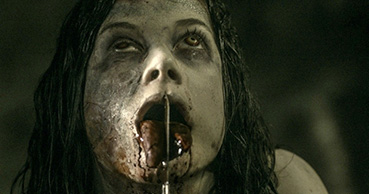|
Remakes are never expected to reinvent the wheel. In the realm of horror, Michael Bay's production company Platinum Dunes has (with depressing predictability) taught us to never expect much of anything. These days it seems that none of our VHS nightmares are safe from being cynically curdled into teal and orange opening week cash-grabbers, shamelessly trading on the notoriety of yesteryear's video nasties and a built-in audience who first saw many of these film's original incarnations peaking out from behind the sofa at home.
Executive producer Sam Raimi is hardly a serial re-booter of Bay's antichrist opprobriousness, but while he may not have massacred Texas Chainsaw or shown us just how unlucky Friday the 13th can be, Raimi too has a history of this sort of thing, besmudging The Grudge and its sequel with GAP model casting and cheap CGI. Raimi's recent ascendency of the blockbuster set made the likelihood of his producing an Evil Dead remake remotely resembling his low budget masterwork even less likely. One only needs to look at his latest multiplex atrocity to see that Raimi is a multi-million dollar shadow of his former self. With money no longer an object, a modern do-over was never going to try and replicate either the low budget look or the Looney Tunes camerawork that characterized the rightly revered cult classic.

Unable to improve upon the imperfections of one of horror's Holy Grails, new director Fede Alvarez is surprisingly neither beholden to, nor in awe of Raimi's precedent. Alvarez understands that in a post-Cabin in the Woods world, it's necessary to play by a different set of rules, re-arranging many familiar stock elements and inventing entirely new backstories so that his version can legitimately be called a "re-imagining" rather than just another lazy re-tread.
Plausibly isolating five twenty somethings in a creepy cabin in the woods, this time around none of them are there for a wild weekend of sex and booze, in fact quite the opposite. Mia (Jane Levy) is a relapsing drug addict, dragged out to her mother's old cabin by concerned friends and estranged brother David (Shiloh Fernandez) in an attempt to try and help her stay clean. Nerdy high school teacher Eric (Lou Taylor Pucci) soon discovers the Necronomicon, bound up in garbage bags and razor wire but that doesn't stop him opening the book of the dead and cosmically screwing himself and his companions in the process.
As the first to be possessed by the freed evil spirit whooshing around the woods, Mia's desperate circumstances are aggravated by the fact that everyone believes her profanity-laden demon howling to be the drugs talking. Characters turning on each other and mistrustingly shifting allegiances informs much of the drama, maintaining high tension at all times between scares.

One character who doesn't appear (until after the end credits) is Bruce Campbell's Ash, a hero of film folklore up there with Snake Pliskin and Dirty Harry, an icon no pretty boy actor could ever do justice or even passably imitate, so slyly positioning a female lead who doesn't take the reigns until way past the film's midpoint is a very smart move indeed. What worked so well for Alien works just as effectively here.
Jane Levy is formidable in the role of Mia, not the ogled damsel in hot pants you might expect, but a quaking victim who in exorcising personal and possessive demons, has to push past her fear threshold and dig deep to find her inner shit kicker. A third act switcheroo in which deadite antagonist becomes avenging protagonist is genuinely thrilling, taking the film to unprecedented levels of giddy, nightmarish violence.
Great as Levy is, it's just not the same without the demigod "Groovy" one and fans are appeased with many knowing nods to Ash's absence. There's the more obvious use of a chainsaw-shotgun combo, but also the way both Lou Taylor Pucci (the other standout of the cast) and Shiloh Fernandez both wear blue collared shirts right off the S-Mart rack. The former's decidedly eighties dress sense and hairstyling is a callback to the Ash of the classic films, whilst the latter's tight fitting duds represent the buff, catwalking modern equivalent that would have likely headlined a less imaginative regurgitation – something the film does a lot.

Through torrents of bile, buckets of blood and gallons of guts, the level of gore is graphic, excruciating and best of all, completely old school. Face-melting, pus-leaking prosthetics betray not a hint of obvious CGI. While the "possessed" transformations of the original films remain far more frightening, expressive and uniquely detailed, it's still great to see a modern era horror fully embracing traditional hands-on methods and getting that special magic which only happens when you have an actor on the set in really good makeup.
Many will say that in pushing the bloodshed and carnage beyond the boundaries of cinema's most explicit scenes of slaughter, this new version has lost all the charm of the originals. I've often heard them talked of in this way, despite the fact that the first one has little of the goofy humour of the sequels and the sequence everybody remembers of a woman getting raped by a tree could hardly be described as such (the protracted 1981 version of this scene endures as the more intense of the two). What's important is that the abiding spirit of Raimi's trilogy and a sense of grim fun remains intact, thanks to a strict policy of in-camera effects. Anything or anyone who can be splattered, severed or sliced is dealt with accordingly. That the relentless sadism isn't totally repulsive is mostly down to the fact that succubuses of Satan are doing the raping and torturing, not the real world snuff sickos of Hostel and the Human Centipede. We stomach it (just) because, like Raimi before him, there's a sense of Alvarez poking and prodding his actors just off camera, cackling manically all the while.

A full throttle horror show right from its opening exorcism, the Roque Baños score is truly something special (somehow eclipsing Joseph de Luca's signature sound), setting a pace that never lets up. As furious and forbidding as anything shown on screen, it sounds like a gaggle of pissed off spirits at a séance gone bad; stabbing violins, atonal screeches and terrifying choral chants ensuring you'll only ever use the edge of your seat. Alvarez mostly dispenses with Raimi's zany framing, Campbell's smooth one-liners and anything else that might distract from the viewer's feeling of shared suffering with these five unfortunate souls, as we fall right behind them on an abject plunge into hell. Interestingly, script polisher Diablo Cody's pop culture quirk is nowhere to be heard, despite her contributions to last minute re-writes. Even the film's few moments of levity aren't enough to let you forget for one second that no-one is coming out of this alive and that when they die, they'll die horribly.
If it nods and winks a few too many times for fanboy approval (you see the obligatory chainsaw scene coming ten minutes before it happens), Alvarez must be applauded for coming up with at least one iconic moment all his own. Metalheads like myself will rejoice at seeing Slayer anthem Raining Blood visualized on screen, a spectacular climatic showdown that bathes the combatants in so much red stuff, it works itself up into a puree lather.
Like all remakes in the shadow of a beloved, incomparable classic, you question the need for its existence at all and even in its best moments, the same question looms large over Evil Dead 2.0 (or is that 2.1, being that Raimi's own sequel is essentially a more buffoonish remake?). If there's not one scene where Alvarez is able to shake the spectre of the Campbell classic, he works hard to create a unique vision, much more than a studio hack looking to make a quick buck off brand recognition. Alvarez can hardly be expect to change the horror landscape the way Raimi did, but when it comes to pushing its boundaries, he's ruthlessly capable of delivering the goods.
An exercise in outrageous extremity, it's a tongue-slicing, limb-hacking, gore-gushing good time, sure to offend many unsuspecting members of the general public. The rest of us can just be thankful it doesn't go so far as to insult the source of its inspiration.
|